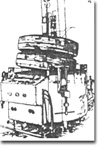PRECURED PROCESS
the precured process of retreading, the chances for degradation of tyre casing due to excessive application of heat and pressure are very much reduced.
In this process, the tread used is with the tread configuration or design already fully cured into the rubber. This vulcanised tread known as precured tread is then applied by means of an unvulcanised layer of fast curing cushion gum/bonding gum wrapped around the buffed tyre casing which is mounted on the tyre rim in a semi inflated condition.
The tyre with the precured tread capped on it and with an inner tube inside is encased in a flexible rubber envelope, covering fully, the exterior of the tyre from bead to bead. The entire assembly is then placed inside the chamber of a pressure vessel called Tread Bonder, wherein steam or electricity is used as the source of energy for heating the chamber to a temperature ranging from 100 degree to 140 degree C, depending upon the curing characteristics of the cushion gum used for bonding the precured tread to the tyre casing. [Fig.I]

When the tube inside the tyre casing is inflated to an optimum level, adequate bonding pressure is developed on the casing encased in the rubber envelope. Curing time is carefully selected depending on the size of tyres. Commercial vehicle tyres require more time while LCV and passenger car tyres are subjected to lesser curing cycles. On completion of cure, the fast curing cushion gum ensures proper adhesion of the precured tread to the tyre casing.
Since the precured rubber used is a premium compound carefully controlled through mixing, and cured at relatively high pressure, it is bound to give very good resistance to abrasion, tear and wear. The precured tread having hardness values ranging between 65 to 70 and good under tread thickness provides resistance to punctures and gives smooth traction.
Degradation of tyre casing strength due to excessive usage of heat is minimised in this process as the temperature employed is much lower than that given for the hot process of retreading. [Fig.II] It has been amply proved that under normal operating conditions, a tyre retreaded under the precured process can give 50 to 75 percent more mileage than that given by a tyre retreaded in hot process, using normal tread rubber. But here again, the quality of precured tread is of utmost importance.
The performance of retreaded tyres in both processes depends mainly on the quality of the inputs used. Care should be taken by retreaders to procure these inputs from manufacturers of good repute.

